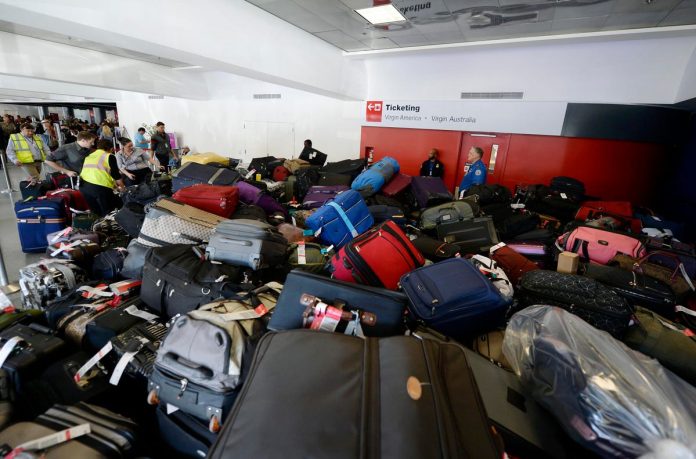There are a lot of possible reasons for airline baggage woes, but this summer is seeing a perfect … [+]
Getty Images
Flying has never seemed to be as much of a crapshoot as it is right now. Cancellations continue to proliferate, delays are more common, and the airlines are understaffed at every turn, from pilots to customer service to the unseen but vital baggage handlers, without whom you cannot get your luggage. Unfortunately, many people flying now are learning this the hard way.
Even if you manage to reach your destination, don’t count on your luggage doing the same.
I very recently went on a golf trip to Scotland with seven colleagues. Four arrived and were missing either their main checked bag, golf clubs or both. They had flown three different airlines on different routings. Four days in, a couple of bags finally arrived, but most did not and at least one person was back home in the States for over a week wondering whether she would ever see her possessions again, before they finally arrived back where she started. Often when luggage goes astray, technology tracking lets the airline tell you where it is. But in this case, they simply had no idea. Another compatriot flew Icelandair and was given a form at the airport that said to call a number and use the lost baggage reference number below. Except there was no reference number below, and the phone went to a full voicemail unable to take messages. I personally read the form and was stupefied. It also said you could check status online, but gave an email address for that, not a website, which is idiotic.
It gets worse. In one of the clubhouses, I struck up a conservation with a group of eight Americans who said they had come over on United from San Francisco, all together, all on the same one-stop routing. One got his checked bag and golf clubs, the other seven got nothing, and they had been in the country for five days with no updates, no deliveries, nothing. Another friend of mine just went to Ireland and flew Aer Lingus. When he didn’t get his luggage, he says was given a phone number no one ever answers, and he too is still stuck in limbo. When he posted about it on Facebook, there were dozens of replies, many with similar stories of luggage never arriving or going to the Middle East on flights to northern Europe. That was just from his small group of friends in the last two days.
The Wall Street Journal just reported that there were three times as many mishandled bags in the first quarter of 2022 than the same period a year earlier. The article noted that two of the biggest airport baggage handling and ground service companies, Swissport International and Menzies Aviation, are currently trying to fill a lot of empty but vital positions, 17,000 and 1,800 of them respectively, as of June 30. The Journal wrote, “Among the worst shortages are at teams that handle baggage, resulting in a scourge of lost and misplaced suitcases this summer. On July 11, Delta flew an Airbus A330 from Heathrow to Detroit with no passengers and instead just 1,000 bags that had been lost.”
The final insult occurs after airlines misplace your luggage, when they tell you to purchase necessary items and submit receipts for reimbursement, then refuse to honor that commitment, as happened to me on a previous trip. They are much better at telling you in person you will be reimbursed to get you out of the airport than at giving you any kind of documentation to that effect, leading to the later “who told you there would be reimbursement?” and “you never should have been told that” excuses.
Spending your vacation running to stores to buy stuff you may or may not ever be reimbursed by the airline for is not even remotely close to the definition of vacation most of us have in mind when we book a pleasure trip, and for something like golf, skiing or many other active pursuits, it’s hard to get around checking baggage.
But more than ever, you really have to begin each trip today with the “what if” thought process, as in “what will I do if my luggage does not arrive. What if it never comes for my entire trip?”
Here are some tips to help minimize the downside.
Smartphone connected trackers in your luggage can be a lifesaver. This is Tile Slim, for your wallet … [+]
Tile
Use Tracking Technology: I put this at the top of the list because it is a cheap, simple and brilliant idea, and all my credit goes to one Jason Deegan, managing editor at Golfpass.com, the digital arm of NBC Sports and the Golf Channel. Jason told me about this and explained that on a recent trip from his home base in California to Hawaii he arrived in Kauai without his clubs. But he had put an Apple Airtag tracker in his bag, and he was able to see that his clubs were stuck in the Honolulu airport, not having made the connection. But the airline could not locate them on their own, so Jason showed them his phone, and they were able to find them in some storage room where they potentially could have languished for days, weeks, or forever. Instead, he got them sent over on the next flight. Likewise, Stephanie Reynolds, spokesperson for Airtag competitor Tile told me, “We’ve had customers tell us that airport officials often don’t have any info about their luggage, until they show them its location on the Tile app and then they are able to retrieve it for them.”
This approach also curtails potential luggage theft. I don’t do Apple, so as soon as Jason told me this, I ordered up a few of the Samsung equivalent for Android phones, the SmartTag. Tile is a non-denominational third-party option, with an app that works for both iOS and Android. The Tile comes in four versions, the Pro (longest range), Mate (designed to clip on to carry-ons and such), Slim (credit card style to go in wallet or passport holder) and Sticker (a small round version that you can put on things like eye glass, headphone or earbud cases). All of these devices were originally marketed for helping you not lose things like keys, so all are small and light, and I recommend hiding them so if your baggage does get stolen the thief doesn’t notice them. They run in the neighborhood of $20-$30 a pop, but are available cheaper in packs of three or four, and are often on sale. Given that they can be used over and over again, the price is insignificant, and if I were going on a luggage vital trip, like a cruise, I would absolutely do this. However, it’s important to know that these devices do not use GPS but instead connect to user networks, sort of like how the Waze driving app looks at other people around you currently using Waze, and success is dependent upon people being near your luggage using iPhones, Android phones or phones with the Tile app. The good news is that airports are generally very smartphone intense places, worldwide. Thanks for the tip, Jason!
I highly recommend backpacks with a big main luggage compartment that opens clamshell style, … [+]
Tortuga
Carry On More: This sounds simple and there are lots of travelers who always go carry on, and they are usually very eager to tell you about it and brag that they never check luggage. I on the other hand, almost always check luggage, because I believe in dressing well when I travel, especially going to other countries and fancy restaurants. I also like to have what I may need for lots of contingencies, and I work out a lot on the road and do a ton of active travel that requires specialized clothing and gear. Also, I don’t like to fight for overhead space, and I don’t like to sit on a long flight in an already too small seat with stuff where my feet could go. But tough times demand tough actions, so I am now embracing as big a carry on as you can get away with, in addition to your personal item, like backpack. I’m typically doing this in addition to checking a bag, not necessarily in lieu of, or checking one bag when I would have done two. Put the stuff that will allow you to survive not having the rest of your possessions, like toiletries and a couple of days of reusable clothing, and I now wear a blazer on the plane, and if the destination warrants it, a rain/warm jacket as well. For golf I carry on my golf shoes, much harder to rent than clubs. I think of it in terms of what can I get by with in a pinch, and as little as possible. But the luggage itself also makes a difference. For a personal item, I’m a big fan of clamshell-style backpacks that opens 270 degrees and hold a full slate of shoes and clothing in addition to laptop/tablet and electronics, and I use ones from Tortuga in a couple of different sizes, which I love, and which greatly augments the actual carry on.
Don’t Check Your Carry On At The Gate: Like much of what is going on in flying right now, this is counterintuitive to how I have always done things. Ever since the airlines lied about unbundling services and claimed that eliminating niceties would lower ticket costs, which got rid of free checked baggage for most travelers, people carry on a lot more, which in turn feeds the now greater cycle of boarding and departure delays. One often successful strategy has been to bring a big carry on you would have checked at the counter if it was free to the gate, and check it there. Almost every flight now lacks enough overhead room, and most airlines will gladly take you up on volunteering to check your carry on without fee, even if they haven’t made an announcement asking for volunteers. But at this point in history, you are trying to avoid checking luggage that you really want to see when you arrive. If you have the chance to “gate check” it and pick it up in the jetway planeside, that is a better bet and still saves you the stress of fighting for overhead space. But if they try to put a regular bar code baggage sticker on your carry on, just say no.
Take Non-Stops, Fly Early and Stick to One Airline: These strategies are not always possible depending on where you are going, but I’ve seen way too many people pinch pennies and take a one-stop because it’s a bit cheaper than non-stop. Just do not do this. Every time you change planes you double the chances of a mishap, cancellation, delay or missed luggage transfer. Flights leaving early in the day are more likely to be on time, and assuming the plane got there the night before, which you can check from home, they are less likely to be cancelled. The travelers I met in Scotland from San Francisco had stuck with one airline and still got screwed on their luggage, but most on my trip who lost theirs did an inter-airline connection to a smaller carrier like Icelandair or Aer Lingus from a big U.S. carrier, and the airlines end up blaming each other for the fumble. I flew Aer Lingus solely, from the U.S., with one stop in Dublin, and my bag and clubs made it.
I trust this guy with my stuff more than the airlines. Shipping your luggage before a trip is pricey … [+]
Getty Images
Ship Your Stuff: Golfers and skiers are more likely to be familiar with this as there are several companies like ShipStix and Luggage Forward that specialize in shipping clubs, skis, bikes, and other sports gear, but you can send any kind of luggage, domestically or abroad. There’s no way to sugar coat it, these services are expensive, and they are not infallible, especially for remote locations. But at the end of the day, they end up using carriers like UPS and FedEx – and you can also just ship directly with them – who I trust a lot more than the airlines, especially given that you can build in as much lead time as you want. You can also just splurge for one way on the outbound leg, since having your luggage delayed on the way home is not nearly as big a deal. This option is especially good for something like a cruise, where once you leave, your luggage from the airline probably cannot physically get to you, even if they find it. Just ship to the hotel you are staying pre-departure.
Consider Travel Insurance – But Carefully: This is a very complicated issue with a lot of potential pitfalls, and in general I don’t recommend it because the frank reality of insurance is that it is never worth what you pay, because that’s how insurance companies make money. However, that’s a long-term view, where if you buy insurance for every trip you lose out, but right now things are significantly more likely to go wrong than they usually are. In addition to often covering costs for delays, rebooking, hotels and meals during cancellations or delays, refunds on missed cruises, etc., these polices often cover expenses for personal items and lost/delayed luggage. But the insurance industry is full of not so reliable players, and this is a case of buyer beware, so it’s up to you to read the fine print, see all the exclusions, and if you can find a reasonably priced policy that covers both the repercussions of delays/cancellations and your luggage – for costs from delays while traveling, not permanent loss – it might make sense.
Split Your Packing Among Checked Bags: Lately when my wife and I travel together, instead of his and her bags, we put half of each of our stuff in each of our suitcases, so if only one arrives at least we both have essentials. You can get really scientific about this, like if you bring two pairs of dress shoes, put one in each bag, really split down the middle, and you can also divide between two of your own checked bags. It’s an easy way to hedge your bets, doesn’t require buying anything and you still pack exactly what you would have, you just spread it out.
ROAM makes excellent quality rolling spinner luggage, duffels and backpacks that can be wildly … [+]
ROAM Luggage
Use Distinctive Luggage and Tag It Well: Admittedly I have no science or data to support this, but I have seen many, many people grab the wrong bag off the luggage carousel, then check the name tag and then put it back, because most luggage is solidly black. If you can’t even recognize your own bag, how can you expect an overworked baggage handler looking through a ginormous pile to find it? The first thing you do when you lose your luggage is fill out a form describing it, and pretty much everyone is putting down “black duffel” or “black 4-wheel roller,” so intuitively it seems that standing out can’t hurt and probably can help. At the very least, you can see your bag come out on the carousel no matter where you are standing, and that makes it less likely that an opportunistic thief – or a confused passenger mistaking it for their own, which happens more than you might think – will grab it. I am a big fan of a company called ROAM that lets you custom design all sorts of bags online, and in addition to being highly distinctive, they are premium luggage of very high quality. I have several pieces, and you can do all sorts of distinct color combos. For bigger checked bags I have polycarbonate hard sided 4-wheel spinners with each half a different color, contrasting wheels, trim, wheels, handles, etc. and I can see them a mile away. So, if I put down “half red/half-blue roller bag” on the lost luggage form, it seems like it would be a lot easier to find. But just going with something other than black helps, and having a colorful, legible, high visibility tag with your info also makes it easier for someone looking for it to find.
Travel well, travel smart, travel safe!













